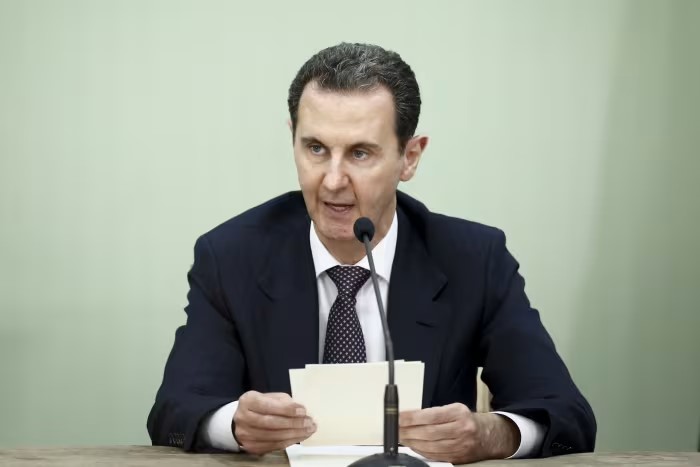Syria has erupted into a vortex of chaos as rebels storm Damascus, toppling the long-standing Assad regime. The capital witnessed unprecedented upheaval, with Bashar al-Assad fleeing the country alongside his family to an unknown location. The military’s confirmation of Assad’s fall does little to quell the ongoing violent clashes.
Russia’s conspicuous absence and lack of support have dealt a devastating blow to Assad’s survival. But the tremors of this political earthquake extend far beyond Syria’s borders. Tehran is now trembling, with Ayatollah Ali Khamenei finding himself increasingly isolated.
The Mullah regime stands exposed, its regional proxies crumbling one by one. Khamenei, once a puppet master of regional politics, now appears as the last desperate remnant of a rapidly disintegrating network of influence.
SYRIA FALLS AS ASSAD LEAVES COUNTRY
Syria has been thrown into unprecedented chaos as Bashar Assad, the long-standing dictator who once used chemical weapons against his own population, has fled Damascus with his British-born wife and three children.
The rebels, led by the Islamist group Hayat Tahrir al-Sham (HTS), have stormed the capital, marking a monumental turning point in Middle Eastern power politics.
Assad’s fall represents the collapse of over 50 years of family rule, with the Syrian television reporting his escape, though his destination remains unknown.
The U.S.-designated terrorist group HTS, led by Abu Mohammed al-Golani, played a decisive role in ousting the Iran-backed regime.
A NEW TALIBAN…..YET A NIGHTMARE FOR TEHRAN!
However, the fall of the Assad regime is no great news for the so-called liberal world. Syria experts warn that while HTS attempts to present a toned-down version of radical Islamism, their ultimate goal remains establishing a Taliban-like society.
The power vacuum left by Assad’s departure threatens to plunge Syria into further uncertainty, with regional powers like Iran and Russia caught completely off-guard.
Both nations had pledged support to the regime just days earlier, but Russia’s Ukrainian entanglement has rendered it strategically impotent.
With Moscow deeply embroiled in the Ukraine conflict, rescuing Assad has dropped to the bottom of its priority list. The smart money suggests Russia has already extracted Assad and his family, providing temporary sanctuary on Russian territory. This isn’t surrender, but a strategic pause – Putin likely calculates a potential comeback once the regional dust settles.
Russia’s case is pretty understandable. But folks, Iran finds itself even more exposed, watching its key regional proxies crumble without a viable backup plan. The Assad departure leaves a massive hole in the Iranian strategic architecture.
The once-powerful resistance network spanning Gaza, West Bank, Yemen, Lebanon, and Syria has been decimated, leaving Tehran strategically naked and exposed.
IRAN’S PROXY NETWORK STUMBLES
Israel and the U.S. have systematically dismantled Iran’s proxy infrastructure. The elimination of key leaders like Yahya Sinwar and Hassan Nasrallah, coupled with the relentless targeting of Hezbollah and Hamas commanders, has surgically weakened Iran’s regional tentacles.
For a decade, Iran weaponized Syria, expanding regional influence through a sophisticated network of proxy groups. The Islamic Republic and its most potent proxy, Hezbollah, were instrumental in propping up Assad’s regime, helping Syrian government forces reclaim lost territories, and deploying Islamic Revolutionary Guard Corps (IRGC) commanders as strategic advisors.
However, after IDF’s direct clash with Nasrallah’s men, Hezbollah’s engagement with Israel triggered a brutal retaliation that decimated the group’s leadership and operational capabilities in Syria.
Without Hezbollah’s critical support, Assad’s regime became a house of cards, waiting to collapse. Russia’s strategic exit made it evident that the Assad regime was in grave trouble.
WITH NO RUSSIAN SUPPORT, TEHRAN STANDS ALONE
Iran’s Araghchi’s empty threats of sending soldiers into Syria rang hollow against the lightning-fast rebel advance. The push was so rapid and decisive that Tehran was left with no strategic options but retreat.
Assad’s fall has left Iran completely exposed, stripping away its last regional foothold. From Syria’s collapse to strategic defeats in Gaza and Lebanon, the Iranian regime finds itself increasingly isolated and vulnerable.
LAST OPTION?
Ayatollah Khamenei’s grand vision of a Middle East dominated by Iran has crumbled spectacularly. This isn’t just a mere setback – it’s an existential crisis. The fall of Syria into rebel hands represents a nightmare scenario for the world.
But for Iran, it is an alarm bell. After the fall of Assad – Iran has only one option – to go nuclear much faster. Because if it doesn’t, America won’t wait for long to hit a final blow.








